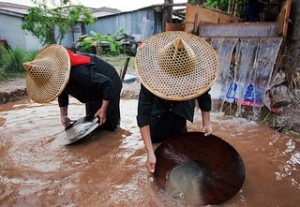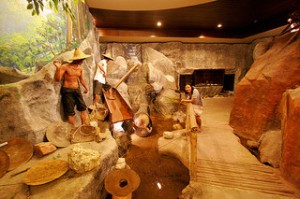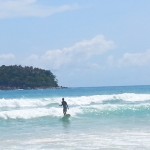Phuket’s Tin Mining Industry, for centuries, along with the rubber and fishing industries has thrived. During the 17th century the British, Dutch and then eventually the French were all in competition for the tin that Phuket‘s Tin Mining Industry produced. The worldwide industrial revolution being partly to blame, as this was a time of great demand, especially for precious metals, and prices were high and business was good.
During the latter part of the 17th century, Siamese King Narai, had become disillusioned with these heavyweight British and Dutch nations coming to Phuket and taking all their tin. So in 1680 the King decided to name a French Missionary Brother Charbonneau the governor of Phuket, whom remained here for several years defying the Dutch and British in their quest for the metal.

In 1685 Charbonneau was replaced by another, as the French took complete control of Phuket. Under the supervision of Chevalier de Chaumont, who was then named governor, he took an absolute monopoly on all tin exports. This also angered King Narai and in 1688 decided to expel the French, there was much inner fighting going on in Siam at that time too.
The following year, Marshall Desfarges was the French general who took umbrage to this expulsion and decided to return to Siam. And re-establish control over the tin mining efforts in the South of the country, as well as try and take control of Bangkok too. With two huge battalions on-board five war ships, they left France in 1689 for Siam, in order to take back what they had lost the previous year.
His instructions, from the Governments of France were very clear: take back Phuket, by force if necessary, and leave a huge French navy presence in the region to warn off any others with ideas of offensive schemes. However, Defarges attack came ultimately to nothing and the French force was sent back with a flea in its ear.
This led to strong nationalistic movements in Siam and after the King organized the Siamese revolution, which would see a massive power struggle within the country. The king would not survive this uprising and died the following year.
Phuket even in the 1930’s would be unrecognizable than the place it has become today. Almost 300 lakes and huge craters scarred Phuket, as thousands of men pillaged the beautiful countryside in order to find as much tin as possible.
Tin was obtained originally by panning the water of local streams, rivers and waterfalls. However, as demand grew so did the size and technical workings of the mining equipment; one can not only see but also imagine the damage this caused.
During those prosperous years, Phuket town really developed and was a mecca for the miners who would seek refuge, in the many bars, opium dens and brothels as well as gambling houses. They would seek fun and frivolity to humour them after the hard core work which came from working in the deep and treacherous mines.
So for centuries, tin mining has been very important to Phuket, right up to the early 80’s in fact. Since then Phuket has had to rely on other methods to make money, including farming, fishing and now tourism. Tin mining died out in the 1980’s mainly due to the explosion of cheaper plastic materials becoming available and hitting the market.
Tin mining had a massive effect on the local environment, huge sways of countryside was left devastated by the mining process. Huge creators were left where the mines had been dug up and left just old stagnant water pits useful for nothing other than hatcheries for mosquitoes. The miners also used other methods to get their booty.
Tin mining dredge boats would troll the local waters around Phuket and rip huge holes in the beautiful coral reefs that surrounded Phuket, leaving mass destruction and devastation in their wake. There still are several of these dredge boats which can be seen today.
However, one would need a scuba diver license, as they lie at the bottom of the sea. The Thai Muang sits off the coast of Khao Lak and at a depth of over twenty meters deep. While its sister dredger boat the Boonsung Wreck lies not far from Tablamu pier.
Both relics of a time when greed took control, ironically, they have both become artificial reefs themselves, actually forming similar reefs to those that which they had once destroyed and now house masses of marine life.

Even now it is still possible to see large sections of land on Phuket still scarred by the merciless mining companies. During a United Nations survey of 1977 it was wrote that areas particularly to the north western side of Phuket were far too heavily damaged to have any building potential.
Just recently, there has been a museum opened to explain the tin mining years of this great province of Phuket. There are both indoor and outdoor exhibits showcased there. The museum cost over 50 million Thai baht to build and is situated on the Kathu- Koh Kaew road just out in the Phuket countryside.
The displays are written up in both Thai and English, there is also lots of old machinery used during the mining process on display there. The building itself is designed in the old Sino-Portuguese style similar to many buildings in Phuket Town.
The museum is open daily from 9am to 4pm. Entry costs are very reasonable there is also free entry for young children and students and Thais over 60 years, they have other offers available too.
To get there, turn off Thepkrasattree Rd north bound by the bypass road junction and Boat Lagoon go past the British International School. A further couple of kilometers you will find the entrance.
Phuket has a very colourful history which will shock many folk, it certainly has not been all plain sailing and sunshine and Singha that’s for sure.




You must be logged in to post a comment.